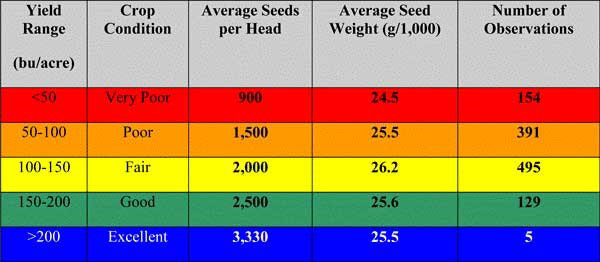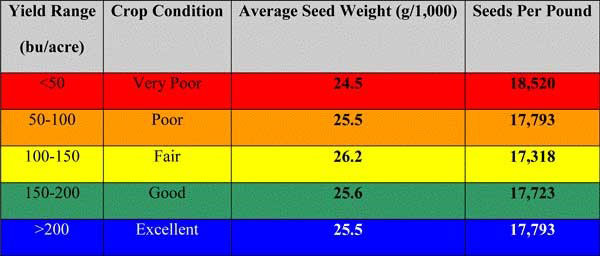Estimating crop yields before harvest can be erratic, but producers often like to know about the potential yield of their crops.
When can I start making sorghum yield estimates?
As the sorghum crop gets closer to full maturity, yield estimates will be more accurate because the seed weight will be closer to being set. Nonetheless, we can start taking yield estimations three to four weeks after flowering (from soft to hard dough stages). At these stages, the final seed number can still change. In addition to the seed number, the seed weight will be only partially determined -- approximately 50 to 75% of dry mass accumulation as compared to the final weight. Each of the main sorghum yield components is discussed in more detail in a companion article in this eUpdate issue, “Grain sorghum yield potential: Understanding the main yield components”.
Variability within the field
Variability between plants needs to be properly accounted for when estimating sorghum yields using the on-farm approach (see next section). Another important factor is the variation between different areas in the field. In general, it is recommended to perform yield estimations in at least 5 to 10 sections of the field to account for field variability.
On-farm approach for estimating sorghum yields
The estimation of sorghum yields should consider the main driving forces:
- Total number of heads per unit area [number of plants per acre x heads per plant] (1)
- Total number of seeds per head (2)
- Number of seeds per pound (3)
- Pounds per bushel, or test weight, which for sorghum is 56 lbs/bushel (4)
The final equation for estimating sorghum yields:
[1 x 2 ÷ 3] ÷ 4 = Sorghum yield in bushels/acre
Take the following steps for making sorghum yield estimates:
Step 1. Number of heads per unit area:
For this on-farm approach, start by counting the number of heads from a 17.4-foot length of row when the sorghum is in 30-inch rows. This sample area represents 1/1000th the area of an acre. If the sorghum is in 15-inch rows, then count the number of heads in two rows. For a 7.5-inch spacing, measure four rows. In each of these scenarios, the area counted will be equal to 1/1000th of an acre.
Take head counts in several different areas of the field to properly account for the potential yield variability. If the proportion of smaller heads, < 3 inches in height, is very low (< 5%), these heads could be avoided due to the smaller proportion they will represent when determining the final yield.
Step 2. Estimation of the number of seeds per head:
The seed number is, by far, one of the most complicated yield components that needs to be estimated. The total number of seeds per head can vary from 100 to 5,000 seeds per head, but almost ¾ of the seed number distribution is around 1,500 to 2,500 seeds per head.
A quick method uses an estimate of seed counts per head, we can utilize a very simple association between the yield level, conditions around pollination/grain set time, and the number of grains per heads (Figure 1). The number of seeds per pounds, or seed weight, is also a factor we need to estimate, but this factor is relevant for yield contribution, with a less clear relationship with yield (Figure 1).
This method of estimating seed counts is summarized in Table 1. If conditions were very poor during pollination and grain set and the general yield environment is low, the total number of seeds per head will average around 500-1,000 seeds per head (900; Table 1). If conditions around flowering were very favorable and the general yield environment is very high, then the number of seeds per head could be around 1,500 to 3,500 (2,500). Intermediate yield environment scenarios can occur if a portion of the three-to-four week period around flowering was favorable and part of it was unfavorable. In that case, the number of seeds per head could range from 1,000-3,500, with an average of 1,745 seeds per head.
This information is provided only for general guidance on estimating sorghum yield potential using the on-farm approach.

Figure 1. Relationship between grain yield and yield components, seeds per head (yellow points, left panel) and seed weight (red data points, right panel). The number of seeds per head has the most direct relationship with yield.
Table 1. Total number of seeds per head and seed weight components.

Step 3. Estimation of the Seed Weight:
A similar procedure can be followed to estimate the seed weight (Table 1). For the seed weight component, the variation documented in the dataset showed a very narrow seed weight variation as compared with the variability found in the seed number component. In general, it seems that lower seed weight is expected at low yield ranges, but the difference among yield levels is negligible. Table 2 shows the conversion from average seed weight to seeds per pound, and from seeds per pound to the seed size factor employed in the examples below for sorghum yield estimation.
Table 2. Seed weight, seeds per pound.

Step 4. Final calculation using “On-Farm” Yield Estimation Approach:
[(Heads x Seeds per Head) x 1,000 ÷ Seeds per Pound] ÷ Pounds per bushel
Example A. Good Crop Condition:
Irrigated sorghum with adequate plant density (48,000 plants/acre), average number of tillers per plant of 1.3, and good yield environment with adequate flowering and grain filling periods:
(48 plants in 17.4 foot -1/1000th of an acre- x 1.3 fertile tillers per plant) = 62 heads
Yield Estimation = [(62 x 2,500) x 1,000 ÷ 17,723] ÷ 56 = 156 bu/acre
Example B. Poor to Fair Crop Condition:
Dryland sorghum with adequate plant density (40,000 plants/acre), average number of tillers per plant of 1.3, and poor flowering but fair grain filling period:
Yield Estimation = [(52 x 1,500) x 1,000 ÷ 17,723] ÷ 56 = 79 bu/acre
Example C. Very Poor Crop Condition:
Dryland sorghum with adequate plant density (40,000 plants/acre), average number of tillers per plant of 1.0, and poor yield environment and growing season (poor flowering and grain filling period):
Yield Estimation = [(40 x 900) x 1,000 ÷ 18,520] ÷ 56 = 35 bu/acre
Ignacio A. Ciampitti, Crop Production and Cropping Systems Specialist
ciampitti@ksu.edu
Tags: grain sorghum yield potential